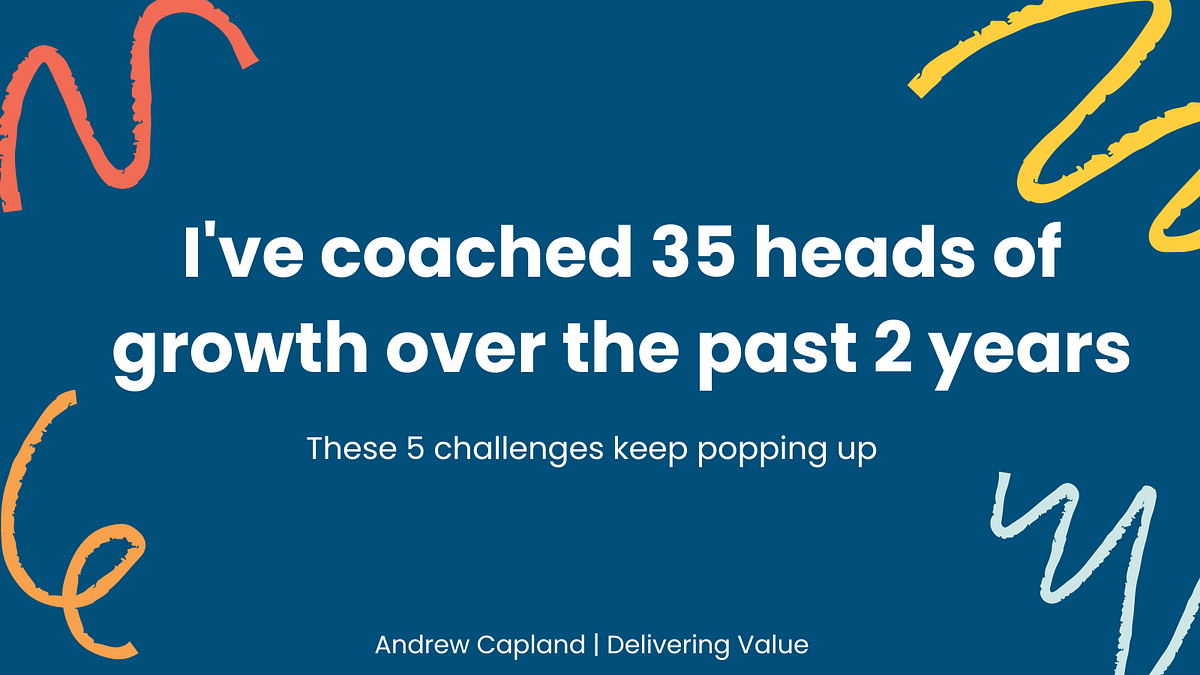
How long does the average head of growth stay in the same role? Two years? Three? Five??
Sadly, I’ve noticed it’s more like 12 to 16 months.
Why so much turnover? Because being head of growth is hard.
If your company is underperforming (which is common right now with everything going on in tech), you might suddenly become the scapegoat. People expect the person with “growth” in their title to fix everything, regardless of the reasons their underperforming are within your control. Over time, that person either gets frustrated and leaves, or the company gets frustrated with them — and lets them go.
On the flip side, life as a winner isn’t easy either. The pace of change can be dizzying. Things are constantly breaking. The goals get more aggressive. And every level seemingly gets harder. In these environments, one of the biggest concerns is that your company outgrows you. They’ll either let you go, or hire someone to sit above you. Neither situation is great and can lead to imposter syndrome, work anxiety, and high stress.
Plus the concept of a growth team is still so new that it means different things to different people. So the head of growth role itself runs a big risk of misalignment between your intentions and others’ expectations.
I’m a former 2x head of growth. I led growth teams at Wistia and Postscript (and worked at HubSpot during the crazy early years). Now, I coach other members of the growth community.
Based on my experience, I’ve identified five common mistakes, or “landmines,” that all heads of growth should watch out for.
Being aware of these landmines can help you anticipate, avoid, and better navigate them, ultimately increasing your chances of success as a head of growth.
Making data-driven decisions is a huge part of working in growth. And, it’s common to feel like you don’t have “enough” data to make the right choices. Especially at an early-stage company.
But here’s the truth… I’ve never met a head of growth who says they have enough data. Enough is elusive.
You always want more. More user touch-points to track. More product data to collect. More segments to explore. More ways to drill down and slice and dice the information. More spreadsheets to review.
In my career, I spent a lot of teams looking for that “needle in the haystack.” That small nugget of information would unlock everything.
Until one day, my manager thought I was taking too long to make a decision. They pulled me aside and asked, “What would you do differently tomorrow if you had this answer today?”
I started to give a long answer… “Well, if the data showed me x, I would want to know this next. But if the data showed me y, then I’d probably explore that next”
(I hear this type of answer all the time with my coaching clients too, just in case you find yourself nodding along.)
My manager waited patiently, then said “Andrew, we’re an early-stage company, speed is an important asset here. What’s the best decision you can make today with the information available?”
I gave my answer.
“Great,” He said. “Now, go do that.”
Feedback like this has helped my approach to data evolve over the years.
My viewpoint has shifted from “What data do I need to make the best decision?” to “What’s the best decision I can make with the data I do have?”
All choices have risks, pros, and cons. Eventually, spending more time searching for that perfect needle in the haystack has diminishing returns. Making a faster call is going to be way more valuable than continuing to search for it.
There are no perfect decisions anyways. So you might as well move quickly and adjust your plan later when you get new information.
As a head of growth, you must drive alignment across the company. Everyone needs to understand what growth is, what you’re working on, and why.
It’s one of the most important jobs — and the biggest potential landmines for these cross-functional roles. Especially at a fast-paced startup.
The growth capability is still relatively new and most people haven’t worked with a growth team before. They usually have different ideas and expectations about your role, which leads to misalignment and friction.
Creating and sharing your own growth operations manual can help address this.
A growth operations manual is a living, breathing document that outlines what the team is working on and how the team gets the work done.
It serves as a central location for important team information, operating principles, collaboration, ownership, etc. It can help to ensure that the team is able to operate effectively and achieve its goals.
It includes things like,
- Who’s on the team and how it fits together?
- Mission and vision
- Goals, objectives, and KPIs
- Operating principles (ie how the work gets done)
- Important procedures and processes
- How growth collaborates with other teams
Here’s a snippet of a blank RACI matrix. It’s a core piece of the operations manual.
But, it’s not enough to create this document. You’ll also need to get feedback on it from the leadership team. Give them space to review everything, ask questions, share concerns — then make adjustments based on their input.
Then, once you have buy-in— “launch” your operations manual with a presentation to your company. Treat it like a new internal feature release.
Moving forward, every time you present or share a project, tie it back to a piece of your operating system & strategy. In practice, it might sound like this:
“Hey everyone — in Q2, the growth team is focused on improving our new user activation rate. And as part of our operating system, we like to experiment before investing deeply. So today, I’m excited to share one of our latest onboarding experiments. Here it is…”
Clarity and repetition are your most important tools. Use every single project as an opportunity to stay aligned.
At startups and scale-ups, heads of growth typically work directly with founders, which can be great for staying aligned and getting access to high-level thought partners.
But, working with founders can be tough. Especially first-time founders. You’ll probably feel like you’re micromanaged at times. Even if you have a ton of experience. And especially at an early-stage company.
It’s one of the reasons a head of growth leaves a new company under 12 mos. They get frustrated.
When this happens, it’s important to remember it’s not on purpose. Nobody wants to micromanage. Most don’t even know they’re doing it.
Your manager just wants to help, and without your guidance on what you need help with, and how they can help you — sometimes that urge to help comes out in unproductive ways.
Like them randomly checking on projects. Giving feedback on something seemingly out of the blue. Or disrupting your current priorities.
If you’re a head of growth, it’s important to remember that you’re in a leadership position. It’s on you to manage up!
One way to do that… use the task-relevant maturity (TRM) framework. It’s outlined in Andy Grove’s classic book for managers and leaders, High Output Management.
TRM is traditionally used as a tool for managers to help their teams and direct reports. But it’s also a sneaky effective tool for managing up too.
Here’s a quick breakdown:
If you already have a lot of experience at something you’re working on (high maturity), proactively let your CEO know that you’ll reach out to them for help establishing success criteria, or if you get stuck.
Then, when working on a new problem (low maturity), let them know you’d **** more of their input to help you get started.
Your manager wants to help. This framework proactively lets them know what initiatives you’d like their help on — and how to get the help you need.
You can bake this into your 1:1 and other docs — so it’s part of your weekly operating system.
If you work at a startup, smart people are constantly chucking new ideas your way. That buzz is what makes early-stage companies so fun. But without the right guardrails, it can also be your kryptonite too.
If you’re not careful, you may end up feeling overloaded and overwhelmed. Or worse, prioritizing the wrong initiatives because someone senior (or charismatic) suggested them.
At this level, working harder or longer isn’t the answer. There isn’t enough time in the day to execute everything. Doing everything is a distraction from the most impactful work. You need a system to comb through ideas and decide which to prioritize.
If you’re looking for a starting point — I am a huge fan of the ICE framework Sean Ellis evangelized many years ago. It’s dead simple and extremely helpful.
Basically, each initiative gets evaluated by these three questions:
● “I” for its Potential Impact
Assuming the initiative is successful, would it have a big impact on your current team goals?
● “C” for your Confidence the Idea Will Work
Do you have prior experience, learnings, or other information that makes you confident the initiative will be successful?
● “E” for the Ease of Implementation
Is this a small initiative that can be executed quickly, or is it a big project that requires more resources?
I like keeping a backlog of growth ideas in Google Sheets, and ranking them on a scale of 1 to 5 for ICE . 1 being the smallest (impact, confidence, etc), and 5 being the largest.
Once a month, I reevaluate my rankings, re-prioritize my roadmap, and strengthen the prioritization muscle.
When you’re hired as head of growth, you’ve been brought on as an expert… and yet the scope and responsibilities for your role usually aren’t well defined. It’s your job to teach them what to do, and how to do it.
To prevent misalignment from happening, I recommend the book The First 90 Days. It was recommended to me by my own professional coach when I started as head of growth at Postscript, and it outlines how to plan for success during your first three months at a new job.
Here’s the quick and dirty version of the 90-day plan that I used:
Days 1 to 30
- Focused Learning — Create your own learning roadmap to help you learn about your customers, GTM strategy, conversion levers, core product value, and company OS.
- Connections/Alignment — Learn about colleagues and their experience with growth teams.
- Early Wins — Projects with immediate impact, like removing friction on the customer’s journey.
Days 31 to 60
- Strategy V1 — begin to develop the first version of your strategy
- Prep Operating System — Assess resources, budget, tools, RACI matrix, and more.
- Start to Ship — Get some of those resources and start down the path.
Days 61 to 90
- Growth Model — Use any additional insights you’ve gained to make progress on your model and set up applicable dashboards.
- Strategy V2 — Use what you’ve learned to revise your approach and refocus on the highest-leverage priorities.
- Growth Roadmap — Hone in on exactly what levers you’ll pull, and when.
Feel free to use whatever works for you from that plan, or download my entire plan if you need more guidance.
These aren’t the only landmines to look out for, but they’re the most common ones that I see.
Leading a growth team involves way more than just avoiding landmines, like creating your model, developing your strategy, running your team, effective experiments, and tracking processes, etc.
Download my entire coaching curriculum for more tips and insights designed to help first times heads of growth thrive — or follow me on Linkedin for more growth & PLG insights…



